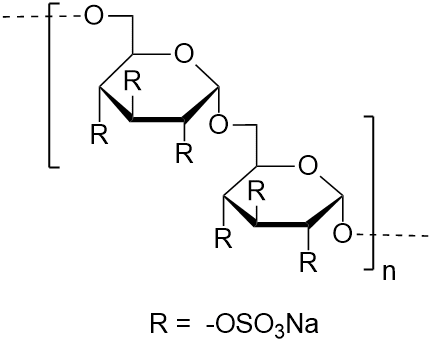Dextran sulfate sodium salt from Leuconostoc spp., average mol wt 9,000-20,000 is widely utilized in research focused on:
- Biomedical Applications: This compound is often used as an anticoagulant in medical research, helping to prevent blood clots during various procedures and studies.
- Drug Delivery Systems: It serves as a carrier for drug delivery, enhancing the bioavailability of therapeutic agents by improving their solubility and stability.
- Cell Culture: In laboratory settings, it is used to create a controlled environment for cell cultures, promoting cell growth and viability by mimicking natural extracellular matrices.
- Research on Glycosaminoglycans: This compound is valuable in studies related to glycosaminoglycans, aiding in the understanding of their role in cellular processes and disease mechanisms.
- Antiviral Research: It has shown potential in antiviral applications, particularly in inhibiting viral infections by blocking viral entry into host cells.
General Information
Properties
Safety and Regulations
Applications
Dextran sulfate sodium salt from Leuconostoc spp., average mol wt 9,000-20,000 is widely utilized in research focused on:
- Biomedical Applications: This compound is often used as an anticoagulant in medical research, helping to prevent blood clots during various procedures and studies.
- Drug Delivery Systems: It serves as a carrier for drug delivery, enhancing the bioavailability of therapeutic agents by improving their solubility and stability.
- Cell Culture: In laboratory settings, it is used to create a controlled environment for cell cultures, promoting cell growth and viability by mimicking natural extracellular matrices.
- Research on Glycosaminoglycans: This compound is valuable in studies related to glycosaminoglycans, aiding in the understanding of their role in cellular processes and disease mechanisms.
- Antiviral Research: It has shown potential in antiviral applications, particularly in inhibiting viral infections by blocking viral entry into host cells.
Documents
Safety Data Sheets (SDS)
The SDS provides comprehensive safety information on handling, storage, and disposal of the product.
Product Specification (PS)
The PS provides a comprehensive breakdown of the product’s properties, including chemical composition, physical state, purity, and storage requirements. It also details acceptable quality ranges and the product's intended applications.
Certificates of Analysis (COA)
Search for Certificates of Analysis (COA) by entering the products Lot Number. Lot and Batch Numbers can be found on a product’s label following the words ‘Lot’ or ‘Batch’.
Número de catálogo
Número de lote/lote
Certificates Of Origin (COO)
This COO confirms the country where the product was manufactured, and also details the materials and components used in it and whether it is derived from natural, synthetic, or other specific sources. This certificate may be required for customs, trade, and regulatory compliance.
Número de catálogo
Número de lote/lote
Safety Data Sheets (SDS)
The SDS provides comprehensive safety information on handling, storage, and disposal of the product.
DownloadProduct Specification (PS)
The PS provides a comprehensive breakdown of the product’s properties, including chemical composition, physical state, purity, and storage requirements. It also details acceptable quality ranges and the product's intended applications.
DownloadCertificates of Analysis (COA)
Search for Certificates of Analysis (COA) by entering the products Lot Number. Lot and Batch Numbers can be found on a product’s label following the words ‘Lot’ or ‘Batch’.
Número de catálogo
Número de lote/lote
Certificates Of Origin (COO)
This COO confirms the country where the product was manufactured, and also details the materials and components used in it and whether it is derived from natural, synthetic, or other specific sources. This certificate may be required for customs, trade, and regulatory compliance.


